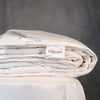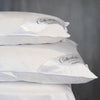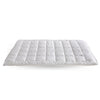Comparison: Animal vs. synthetic fabrics in duvets & pillows

In this blog article we want to focus on the comparison between duvets and pillows with animal content, i.e. down and feathers as well as those made of synthetic, man-made fibers.
What are animal and synthetic substances anyway?
Animal substances:
As a rule, this refers to the down or feathers of animals. The down is still under the feathers and is responsible for the temperature balance in winter and summer. They are particularly breathable and can store heat particularly well thanks to their three-dimensional structure. Feathers are not quite as advanced in terms of their properties, but they also ensure that the animal is protected from external environmental influences. Typically, duck and geese down and feathers are used. These can also differ in quality.
Synthetic fabrics:
Synthetic fibers are made from coal, natural gas or petroleum. The respective starting material is first chemically synthesized into small plastic balls and then adapted in such a way that small threads can be drawn from them. These are then refined and processed into various textile fabrics.
The most well-known synthetic fabric is probably polyester. The smooth threads of polyester are very thin and fine, but at the same time very stable and tear-resistant. Therefore, they are often used in textiles, especially in the sleeping area.
Heat retention & insulating ability

When comparing the thermal properties of animal and synthetic materials, there is a clear winner: nature. So far, man has not managed to develop an artificial material that has the same insulating properties as that of our animal friends. If you generally freeze more easily at night, you should definitely use a down comforter.
The down forms small air cushions among themselves, which store heat particularly well. In addition, they are very flexible and nestle seamlessly against your own body at night. As a result, the heat can hardly escape, even if you move a lot during sleep. The cuddle factor is therefore a lot higher with animal products.
moisture absorption

The human body can lose up to 500ml of moisture during sleep. It is therefore very important that the inner workings of a duvet can also absorb moisture well.
Animal-based down and feathers absorb up to 15 times more moisture than synthetic fabrics, according to a Focus Online report, making it the clear winner. Because you sleep much drier, the quality of sleep is also much better. This prevents you from waking up in a sweat at night as best as possible.
Weight

The feathers, or down, and from animals are lighter and more airy than their synthetic competitors. As a result, the original down comforters are not as thick and heavy. This has a positive effect on sleeping comfort. Especially in winter there is not so much weight on your own body.
For people who move more during sleep and also toss and turn more often, the down duvet feels more flexible and cozy because it follows the body's movements better.
Due to the lower weight of the down duvet, the air can circulate better and faster, which also improves the quality of sleep.
A one-sided thing then?
Not quite. For example, some people like the blanket to be heavier because they feel they can curl up better.
The synthetic material also insulates better when it gets very wet. Polyester is therefore often used in the processing of outdoor jackets. As a rule, however, the bed at home is not affected by greater dampness and moisture; therefore this point is negligible.
Which material is easier to wash?

Since animal down and feathers are a natural product, you have to make sure that all down and feathers in the pillow dry as best as possible, especially after washing, before the duvet cover is pulled over again. If some feathers are still slightly wet, unpleasant odors can develop, which should be avoided. It is therefore advisable to dry the blankets in the dryer.
Both down duvets and synthetic duvets can usually be washed at up to 60 degrees. Mites can nest equally in both types of ceiling. With a wash, however, these are quickly removed again.
Synthetic products also have the advantage that they dry faster after washing and actually do not produce any unpleasant odours. A pillow with an artificial fiber filling can smell a bit chemically at most when you first unpack it. However, the smell dissipates very quickly.
sustainability

The International Down and Feather Bureau (IDFB) analyzed the ecological footprint of synthetic and animal products in 2019 and found a surprisingly clear winner: animal products.
The results show that down fill material has between 85% - 97% lower environmental impacts in the categories studied, as can be seen in the figure below:

Polyester fill has 18 times greater impact on climate change than down. Why is this?
Synthetic blankets are very often made of polyester. Polyester is made from petroleum and is therefore to be seen as very critical in terms of sustainability.
Value for money: What about the costs?

Synthetic blankets and pillows are much cheaper to buy than animal pillows and blankets. In particular, allergy sufferers who have no choice but to resort to the artificially produced fibers benefit from this.
However, for those who want the better and higher quality product to sleep on, they should resort to animal products. The warmth properties, the cuddly soft feeling when falling asleep and the quality of sleep at night make nature the winner.














Leave a comment